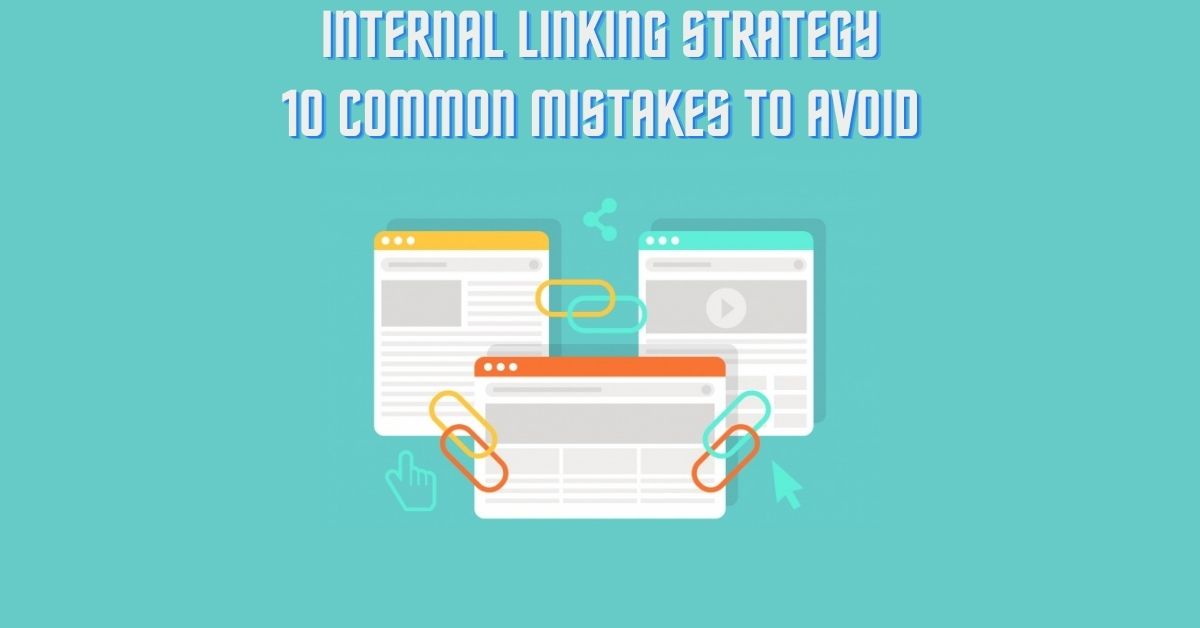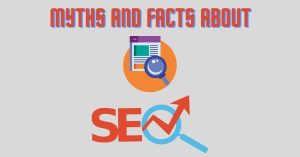While several factors collectively determine your SEO success, link building is one of the most important ones. When it comes to creating a good link-building strategy, most marketers focus on backlinks and overlook internal links—which can cause more harm than good to your link-building efforts.
Often internal linking gets overlooked while focusing on and engaging in actions for external linking, but it still contributes a significant amount to your overall search engine ranking.
Internal linking might look pretty straightforward but can sometimes be tricky for experts too. So, here’s an extensive guide on the ten most common mistakes you should avoid when creating an internal linking strategy. In addition to detailing all the errors, this post will also walk you through the best ways to address them and create a bulletproof strategy.
Table of Contents
Why Do You Need an Internal Linking Strategy for SEO
Simply put, internal links take you from one page to another in the same domain. They help visitors navigate different site pages easily by interconnecting them and allow users to stay on the website for a longer period.
Here’s how a solid internal linking strategy can benefit you:
Internal Links Increase Your Visibility
Internal links put you in Google’s sight. Every search engine—like Google crawls through web pages and discovers new content when it follows a link to another page. So, building a good internal linking structure essentially makes you visible on search engines, allowing your audience to find you easily.
In Google’s own words, “…pages are discovered when Google follows a link from a known page to a new page.”
Internal Links Build and Distribute Authority
Google’s PageRank algorithm assesses all web pages for quality and authority to determine where they would rank on search results. Internal linking helps improve your website’s ranking by building authority for multiple pages.
If one page is ranking high, then adding links to other pages would distribute that authority. Despite stopping the PageRank Toolbar, Google uses the algorithm for ranking pages, thus benefiting websites.
Internal Linking Enhances User Experience
User experience forms a key part of SEO, controlling factors like bounce rate and page dwell time. By creating a good internal link architecture, you are helping the users navigate the website easily. This naturally enhances the UX and improves your overall performance.
Common Mistakes to Avoid When Building an Internal Linking Strategy
Strategic planning is crucial to building the right link structure, whether you’re building a website from scratch or working on an existing one. While you are strategizing your internal links, try to steer clear of these mistakes.
Using Inadequate Links
Not using the right links is perhaps the biggest mistake you can commit. By sending the reader to a broken or unavailable link, you inevitably increase the bounce rate and lose credibility for your website.
Overall, various kinds of wrong links can hamper your link structure.
- Broken Links: This is the most common type of bad link caused due to a lack of regular maintenance. You will have a broken link if it contains the wrong URL or links to a deleted page. Updating the links promptly is important to fix this.
- Redirect Chains: Another kind of wrong link that can potentially upset the viewer is an endless loop of redirects. If you send a visitor from one page to the other via a long route, they might bounce off. So, avoid adding indirect links that redirect to another page to minimize bounce rate.
- Temporary Links: Just as broken links hamper your site’s performance, temporary links also damage the overall linking structure. These links will end up giving a 404 error and convey your site is not fully functional. Instead, replace all temporary links with the actual pages on your site.
- Masked Links: Google’s Webmaster Guidelines consider masked links as deceptive. So, if you use them, you might get banned or penalized. Besides, masked links are not visible to the visitors and will not fetch any good results.
The Fix
The best way to avoid inadequate internal links is to audit your website regularly. Perform checks to detect any broken or wrong link and remove or replace the link. Ahrefs allows you to audit your site and identify all the broken links with detailed reports.
You can either reinstate the pages for these broken links or create a redirect for the broken links to an existing page.
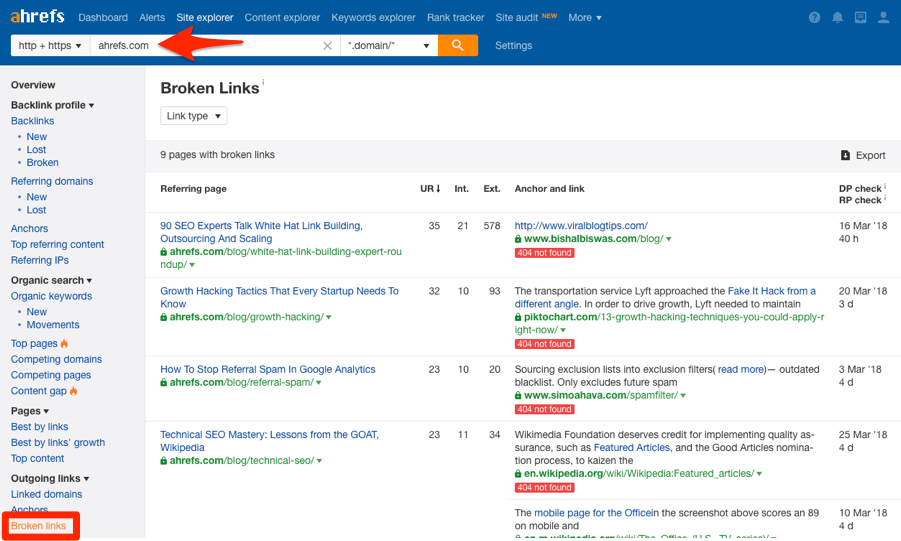
Choosing the Wrong Pages for Linking
The strategic part of creating an internal link strategy is to know which pages to link.
The easier way of going about it is to create multiple internal links for that one page you want to rank high to manipulate rankings ethically. Most marketers use different anchor texts to add links to the same page. While that may seem like the best solution, it can prove ineffective.
So, what exactly is the right way to choose pages for internal linking?
Create links to pages with low visibility on pages with high authority and ranking.
The easiest way to do this is through a very quick site audit. Let’s understand the steps to do this with an example.
Let’s consider that Hubspot wants to publish a new blog on Hyper-Personalization.
To identify the best page for linking this new blog, they can first search for site:yourdomain.com “keyword or phrase related to page” on Google. This keyword will be the one that they are not already ranking for, in this case, hyper-personalization.
The search results will show up all the high-ranking pages that contain this keyword. Now, they can link the new blog to their article on mastering website personalization or email marketing.
Pro Tip: SEMrush’s Backlinks Analytics tool can also come in handy with its detailed data reports!
Using Links with Nofollow Attributes
There are two attributes for a link—follow and nofollow. In simple terms, the follow attribute allows the search engines to crawl through the linked page while the nofollow attribute suggests otherwise.
A nofollow attribute essentially means you are asking the search engines to ignore the given link.
So, if your internal links contain the rel=nofollow attribute, then you are willingly stopping them from discovering your pages. This will naturally hamper your website’s authority and hamper the new pages from ranking on search results. It also stops the link juice—PageRank authority between the linked pages.
Google’s guidelines clearly state that nofollow attributes lead to dropping the target links from the web.
The Fix
To eliminate nofollow links, you have to first check which links contain this attribute.
- An easy way to do this is by simply right-clicking anywhere on the page. From the options, select View Page Source.
2. Press CTRL + F to search “nofollow” to find the links with this attribute.
Backlinko also recommends using the Strike Out Nofollow Links app for easy and quick results.
Incorrect Placement of the Links
Another bad SEO practice for internal linking is the wrong placement of links.
The most glaring example of this practice is putting the links in header tags. The simple logic behind this is that Google’s search crawlers consider headings to organize the page. Placing links in these headings confuses the crawlers, and they consider it spam.
Besides, if you use header tags as anchor texts to a completely irrelevant article, that can hurt even worse.
It’s best to place links within the content—whether a blog or any other page—with the right anchor text. Another great solution is to use buttons that prompt the visitors to click the link and make it easy for the search engine crawlers.
Overlooking the Orphaned Pages
If you leave any page on your website without any links leading towards it, the page is orphaned.
Orphaned pages have low visibility and are difficult to discover. The simple reason is the lack of links pointing to their existence. This naturally deters the search engines from crawling these pages since there is no way of finding them.
You can find examples of orphaned pages on your website as well. If you had once created a page for services that you no longer provide, then you will no longer have any links pointing to that service page. The same is applicable for any products that are no longer in stock but have a dedicated page. They are now orphaned without any links pointing towards them.
The Fix
The most straightforward solution for this error is a site audit.
- Create a complete list of all the pages on your website.
- Use any website crawler software, like SEMRush Bot or Screaming Frog.
- Review the results for pages with zero inbound links. These are your orphan pages.
- Perform a periodic audit to identify these pages and delete them.
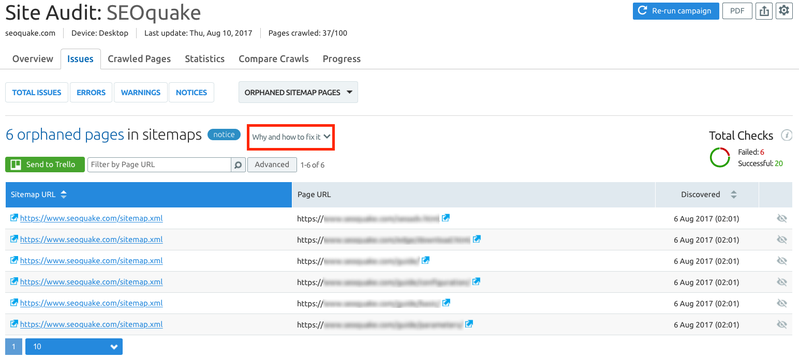
Using Anchor Texts Without Keyword Research
Anchor texts are one of the most important aspects of link building, whether external or internal.
Simply put, an anchor text is a clickable text hyperlinked to a different page.
At its best, an anchor text can provide the best idea about the linked page.
At its worst, an anchor text can ruin your entire internal linking efforts.
The Fix
In Sean Work’s words, the best way to use anchor texts is to write them as if you were describing the page to a blind person.
Descriptive anchor texts can work wonders for your internal links.
To put it into better context, if you’re linking a page of the best workstations, then here’s the right and wrong usage:
Right: You can choose from the best workstations to make your pick.
Wrong: Choose the top chair-table combination from a selection of the best workstations in the market.
A few factors to consider when curating a list of anchor texts are –
- Select a set of well-researched keywords for which you wish to rank the page.
- Diversify your set of anchor texts to include natural words and avoid repetition.
- Go for long-tail options for the selected keywords to increase the chances of ranking higher.
- Avoid forcefully adding anchor texts or links in irrelevant contexts.
Inadequate Crawl Depth for Key Pages
Crawl depth of a page may refer to the number of clicks it takes to reach any concerned page from the homepage.
It is related to the site’s architecture. The depth of any page correlates to its importance for search engines. The bigger the crawl depth, the less important crawlers consider the page.
Botify’s research shows how Google misses out on crawling pages with bigger crawl depths.
If you place one of your most important pages—say, one that talks about your main services, 5-10 clicks away from the homepage, then crawlers will take it as less important. But, if your main service page has a crawl depth of 1 or 2, it automatically becomes an important page.
The Fix
To ensure a higher ranking for your key pages, it’s important to ensure they have a low crawl depth. So, conduct another audit to evaluate the crawl depth for your most important pages and reduce the clicks from the homepage.
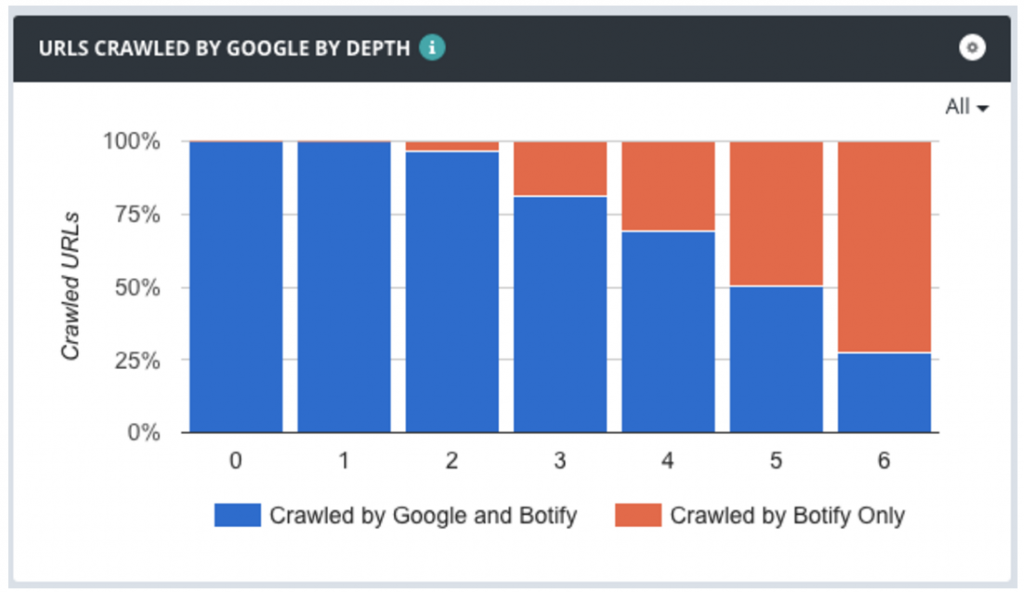
Not Building Links for Images Properly
Brain’s research concludes that people retain only 10% of the information they read through texts but remember 65% of the information acquired through images.
An often overlooked part of internal linking is images.
So, if you want to make your page a lead magnet, start making the best use of image links. The fact that 32% of marketers consider images as their power tool for digital marketing shows how much you can miss by overlooking image linking.
Here are a few things to consider while building links for images:
- Create engaging images that people want to share on their profiles.
- Make infographics to provide detailed yet digestible insights on the subject.
- Use high-quality graphics made with tools like AdobeStock.
- Add alt tags and descriptions to make your images discoverable.
David McSweeney from Ahrefs extensively details the TRUST formula to create images that attract backlinks to your web pages. This will aid in building a solid internal and external linking strategy. The TRUST framework requires you to assess these parameters: Trending topic, Research and analysis, Unique takeaway, Simple visual, and Tactical promotion.
Adding Too Many Links
The end-user should lie at the very core of your internal linking strategy.
Add links to any page, considering the visitor’s perspective. If a link doesn’t add value for the visitor, remove it. The user experience and engagement are far more important for your internal linking strategy than the link juice flowing through the pages.
Consider linking from the point of view that the linked page is so important that the visitors have to stop what they’re already reading and jump to the linked page. If the linked page fails to add the expected value for the visitor, it causes immediate dissatisfaction. More importantly, there is little to no context for Google’s crawlers to assess the links.
To that end, overwhelming your page with too many links is bound to backfire.
If your objective is to simply build more links at the cost of user experience, then you are willingly letting go of a higher ranking. Besides, PageRank is divided equally between all the links on a page. This will result in a lower value allocated to each page.
The Fix
Link only to the pages that are relevant to the concerned page. A good way to bring relevance between your pages is to evaluate the content going on every page. This will give you crucial insights into the content elements that can bridge multiple pages.
Not Creating the Right Navigational Links
Navigational links help users browse through the entire website. They form the website’s menu with a collection of the entire site’s pages.
While the navigation bar is an important part of a website, marketers can often overlook this part in their internal linking strategy. Creating a link-heavy navigation bar is a common error, while not adding all the links is another mistake.
The Fix
The best way to build a navigation menu keeping your internal linking goals in mind is to follow a parent-only style.
Using this style, you can add links to the main parent pages and link the child category pages to their respective parent pages. You should aim to create an intuitive navigation bar making it easy for the users to browse through your website.
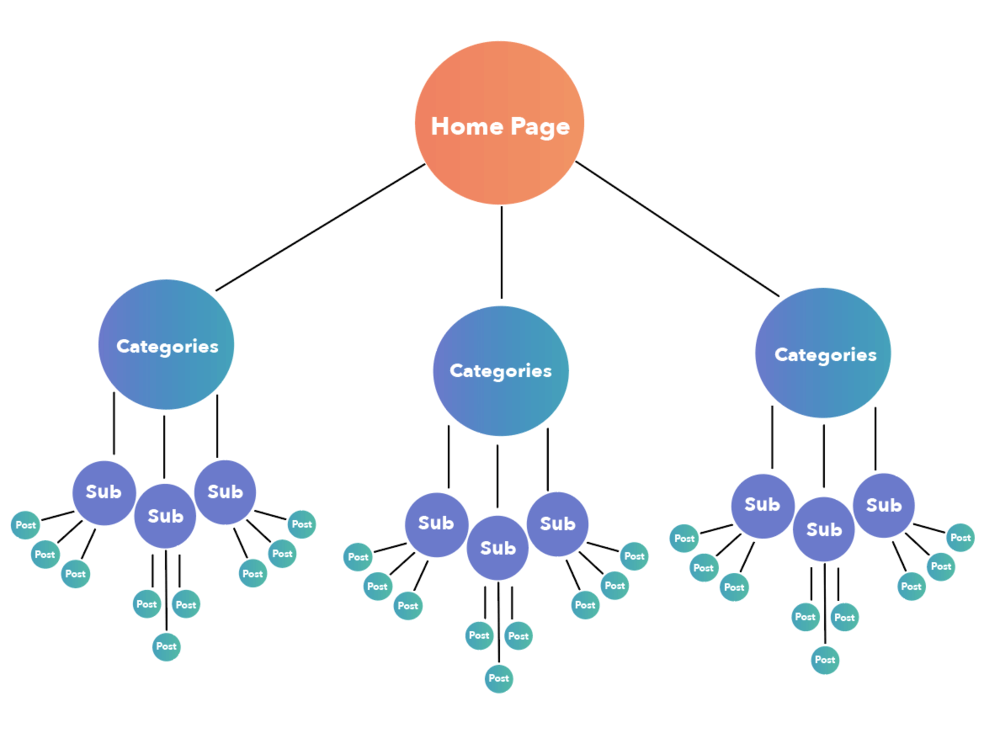
Conclusion
Ranking higher on Google requires a solid SEO strategy. Before anything else, start with a well-planned internal linking strategy, and you can make your way towards a higher ranking for your website.
With a strong internal linking architecture, you can build authority for your website, gain visibility, and secure higher ranks on Google, thus driving quality traffic to your website that can convert into paying customers.
But building a good internal link structure involves several elements. If you are building your own strategy, then consider the above-detailed mistakes to avoid negative results.
Use these points to your advantage and create a logical and intuitive structure for your website.
If you liked what you read, do share this article.
Feel free to leave any suggestions or feedback.
If you need any help with other topics related to SEO, you can check out our SEO section.
Affiliate Disclosure
Some of the links to products on this blog are affiliate links. It simply means, at no additional cost to you, we’ll earn a commission if you click through and buy any product.

